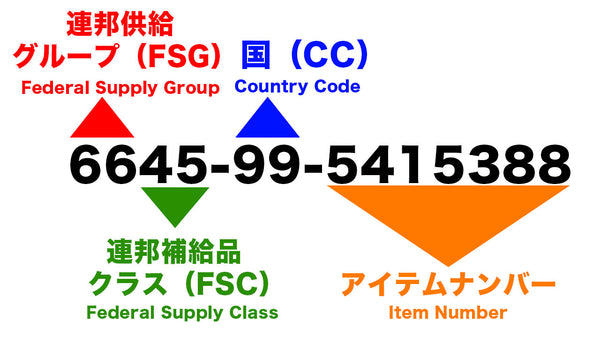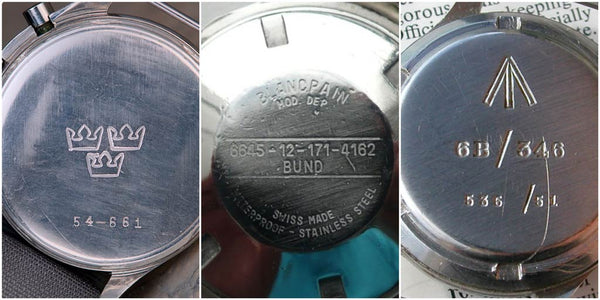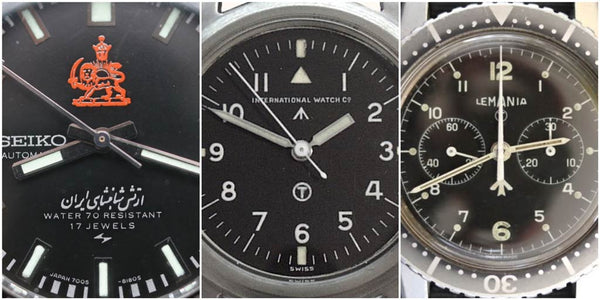Time Speck: Decoding the Code of Military Watches
Hello.
This is Seno from Vintage Watch Life.
In today's video, we'll explain the numbers and symbols on military watches, which can be difficult to understand without basic knowledge. If you just know this much, you'll be able to understand them to a certain extent!
I will be talking about the following topics.
One of the interesting features that sets military watches apart from commercial watches is the issue mark.
These numbers or symbols, sometimes found on the dial, but most often on the case back, have different meanings.
The long string of numbers tells us important information about the watch, such as where it was made, how it was used, and when it was made.
This video provides a quick guide to deciphering the majority of issue marks on military and government issued watches, showcasing the major marks and some examples of each.
By the end of this video, you should have a basic understanding of most issue marks on military watches you will encounter.
The table of contents is as follows:
1. Serial number
2.
3.
4.
5.
6.
7.
8.
So let's get started right away.
serial number
This is the most common issue mark among all issued watches.
A serial number is a unique number assigned to each watch that allows us to track each individual watch in our inventory and maintenance systems.
For example, 000-0000 was issued on April 1st and had its first overhaul on December 1st.
This means that you can manage things like that.
The serial number is almost always engraved on the case back, and there may be multiple serial numbers depending on the issuer's sourcing method.
Watches made for military use and not sold to the public often only have one serial number, while commercial watches or watches modified for military use may have both a maker and issuer serial number.
For some watches, the serial number is the only identifying feature that distinguishes the watch from other commercially available watches of the same manufacturer.

From left:
US BENRUS TYPE 1, STERILE - The serial number is engraved only on the back of the case.
BRITISH CWC G10 - serial number is on the second line from the bottom.
FRENCH MARINE NATIONALE CASIO G-SHOCK DW-9000 - The only difference between this and commercially available models is the serial number.
date
Another very common marking on the back of an issued watch is the date.
Although it looks simple, this mark is a little harder to understand than the serial number.
Date markings on military watches have several meanings, but most refer to the date the issuing authority received the watch from the manufacturer.
Because watches may be held in government inventory for months or years, the date on the watch may not reflect the actual issue date to the soldier, sailor, or airman who wore it.
Similarly, there is a date marking indicating the year the item was ordered from the manufacturer.
In this case, the case back will show the date of the original contract, even if the watch was produced for years under that contract.
Finally, there is also a date mark that indicates the year the watch was manufactured.
This again makes it difficult to know when and to whom the watch actually arrived.
Unfortunately, few watches actually have the date given to their owner engraved on them, leaving collectors to infer it in other ways.

From left:
RCAF BREITLING - Contract Date "67"
RAF JLC MK XI - Purchase date "53"
US HAMILTON MIL -W- 46374A - Date "NOVEMBER 1972"
Stock Number
Tracking contracts and inventory is a critical process in the military, as it is in any large organization.
With millions of items to track over decades of procurement, the U.S. government developed a numerical system to track everything it buys and owns.
Then in 1953, the government began using the Federal Stock Number system.
This system uses an 11-digit number, including a location-specific number, to define the type of item and the specific item itself.
In 1974, the code was officially internationalized and two additional digits were added to indicate the country in which the item was registered.
The code now has 13 digits and has been renamed the National Stock Number System.
Internationally, this number is known as the NATO Stock Number and is the primary classification system for NATO's 30 member countries and approximately 30 non-member countries.
Not all European countries are members of NATO, and there are non-member countries, but even non-member countries manage their military equipment using NATO Stock Numbers.
(As of July 2022, Finland and Sweden will also officially join NATO.)
The first six digits of the NSN (National Stock Number) tell you what the item is and where it was registered.
Now, please look at the part surrounded by the red frame in this image.

This means that items of the same type will have many of the same numbers, regardless of when or where they were coded.
This may be a little difficult to understand, but for example, if it's a British military watch, the first one to start with would be 6645-99.
Now let's go into more detail about each number and what it represents.
Please see this illustration below↓
 The first two digits are called the Federal Supply Group (FSG) and refer to the overall category of the item.
The first two digits are called the Federal Supply Group (FSG) and refer to the overall category of the item.
For most watches, the FSG is "66 - Instruments and Laboratory Equipment."
Following the FSG (Federal Supply Group) is the two-digit Federal Supply Class (FSC), which further narrows the item category.
Of these, the clock is specified by "45" , which represents "testing equipment" .
So for military watches, the FSC would be "6645 - Time Measuring Instruments".
The next two digits are the Country Code (CC), which indicates the country where the item was originally contracted and coded.
Typical CCs commonly seen on military watches include:
・America = "00" and "01"
Germany = "12"
Australia = 66
・The UK is "99"
is.
For a complete list of country codes, see the NATO website .
A good place to view the FSG and FSC is the Defense Logistics Agency website .
The last 7 digits of the NSN are the item number, which is unique to that item.
※Note
Please note the difference between the serial number and the item number.
While the serial number is unique to each watch, the item number is the same for all watches made of that type (all watches supplied under one contract).
This item number identifies exactly one type of watch (or other coded device).
While the U.S. military and government agencies rarely issue watches directly to the military, manufacturers still supply watches and give them the NSN.
Obtaining an NSN puts the watch into the procurement system and allows units to place individual or group orders for the watches.
Marathon watches, which supplied navigator and field models to the U.S. military until the 1990s, still have NSN engraved on their commercially available watches.

From left:
SWEDISH AIR FORCE LEMANIA TG 195 - Three Crowns Engraving
GERMAN BLANCPAIN FIFTY FATHOMS - "BUND" engraved
BRITISH IWC MK XI - BROAD ARROW (PHEON) SCULPTURE
Finally, we would like to reiterate that not all watches have this code; it was established in 1974, so all military watches made after that date have the above code.
Government mark
The government mark is a little different than previous ones.
It's more likely that it's printed on the dial rather than engraved on the case back.
Government markings identify the country or government that issued the watch and indicate that the watch is government property.
Marks using words, initials or symbols are the most common, with the words or initials usually representing the issuing country or government armed forces.
For example, "US" stands for the United States of America, and "BUND" stands for the German Bundeswehr or Bundeswehr.
Similarly, symbols are used to represent the issuing government and to indicate government property.
The most famous is the Broad Arrow, which was used in 17th century England to mark government (royal) property.
A familiar symbol to military watch collectors, the wide arrow appears on the dial or case back of almost all British made military watches.

From left:
IRANIAN SEIKO 7005 - "ARMY OF THE SHAH" DIAL TEXT
BRITISH IWC MK XI - Broad Arrow dial printing
SAAF LEMANIA 1872 - Broad Arrow dial
Other marks
While the above list is not comprehensive, it should provide a basic understanding of the marks issued and how they can be used to identify most military watches.
Here are some other marks you may occasionally see on issued watches:
Contract Type
Issued watches can be purchased in a variety of ways, and sometimes the method of purchase is watch specific.
Examples of standards include MIL-SPEC and Army Trade Pattern (ATP).
Contract Number
As with the above types, the watch may have a specific contract number on it that is used to purchase that batch of watches.
Benrus watches from the 1960s and 1970s are a good example, purchased by US military suppliers under various contracts.
Purchasing or issuing department/branch/unit
When a batch of watches was ordered, the manufacturer or government official would sometimes be more specific about who was ordering the watches.
The contemporary British system is a good example, often specifying which branch of the military originally ordered (or paid for) the batch.
Typically, the NSN is preceded by a three or four digit number that designates the purchasing department.
The Royal Air Force is "6BB", the British Army is "W10", the Royal Navy is "0552" and the Royal Marines is "0555".
Confusingly, however, such watches may also have been issued to other branches as required.
The branch name simply means which branch you purchased from.
Manufacturer Part Number
Similar to a government inventory number, a manufacturer part number allows an item to be tracked within a manufacturer's production system.
What did you think.
Now you should be able to decipher the issue markings on military watches.
So, go find a new military watch that inspires you!



